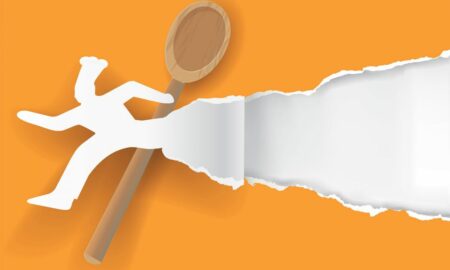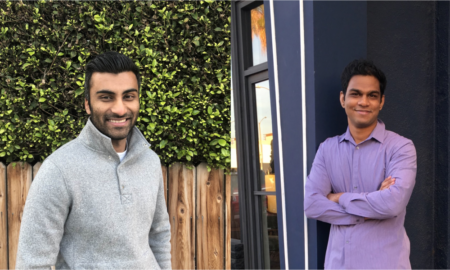We are thrilled to be connecting with Bartosz Beda again. Bartosz is a Figurative Abstract Painter and is also a content partner. Content partners help Voyage in so many ways from spreading the word about the work that we do, sponsoring our mission and collaborating with us on content like this. Check out our conversation with Bartosz below.
Hi Bartosz, thank you so much for sitting down with us again. For folks who might have missed our initial interview, can you start by briefly introducing yourself?
Bartosz Beda moved to Dallas at the end of 2018 with his wife and daughter. His wife works for Southern Methodist University. Beda is an emerging artist with a strong national and international exhibition record. He was born in 1984 in Poland, where he grew up surrounded by like-minded art-focused people.
Beda is primarily a painter with an interest in sculpture and animation.
He worked on animation in the film industry, including two movie productions; Ichthys by Marek Skrobecki (2005) and Peter and the Wolf by Suzieh Tempelton (2006), which received an Oscar in 2007.
Around 2008 he moved to the United Kingdom to study at the Manchester School of Art. He earned a Bachelor of Arts degree and graduated with honors, and then went on to pursue a Master’s degree in Fine Art. Since then, he has won national competitions and exhibited across the United Kingdom, Europe, South America, and the United States.
In 2012-2013, Beda was awarded a six-month scholarship from Manchester Metropolitan University to attend the Academy of Fine Arts in Dresden, Germany. In 2016, he received a fellowship from Fondazione per’l Arte in Rome, Italy. In 2018, Beda was awarded a fellowship residency at GoggleWorks Center for the Arts in Reading, Pennsylvania.
Bartosz Beda was featured by BBC Radio 4 in February 2013 as ‘one to watch.’ Beda’s artworks are in public collections at the Reading Public Museum, Brownsville Museum, Siena Art Institute, and Fondazione Per’l Arte, as well as in private collections throughout Europe, the United States, South Africa, and Asia.
![]()
You’ve been in the United States for almost seven years and in Dallas for the last three years. How has the US changed you and influenced you as an artist?
It has been an enjoyable journey during which I learned a lot, and I continue to learn every day. When I moved to the United States from Europe, it was a significant cultural and personal adjustment that changed me, both as an artist and person. I knew that the United States is a big country and that travel between states might seem easy, but it is actually not as easy as traveling between countries is in Europe. I think I underestimated how much this move could affect me as both an artist and person. I first spent five years in rural Idaho. In many ways, this stint slowed down my visibility and exposure to the art market. Toward the end of my stay, I was very depressed and was looking for a way to get out and start a new chapter. Don’t get me wrong, I learned a lot about myself and my painting matured, but at the same time, it was a miserable experience for my soul.
The future is looking brighter in Dallas. I love the dynamics of the city and region, and I’ve gotten used to the fact that I can drive for an entire day and still be in Texas.
The most crucial fact that I now know about myself, which is one that I didn’t want to admit while I was in Idaho, is that I often say my thoughts aloud. This is not always understood or received positively and it complicates my relationships with others. The reason behind this might be that I spend most of my time by myself in the studio. Perhaps when I see people, my instincts go wild.
You are now working on an ambitious large scale painting series which hopes to address the current issues immigrants and Asian-Americans are facing in the US. Could you tell us about your need to create these artworks and the motivations behind your work?
I often switch between small and large-scale canvases. The pandemic has influenced my way of working in the studio. I used to paint every day, and nowadays, I reflect a lot on what I paint and sometimes end up abandoning a canvas for a while to rethink and reconsider what I do as an artist, painter, and human being. I decided to take my time when I work on a painting. It may be my reaction to the constant gratification that social media has taught us, but I want to spend time with my paintings and contemplate the process. I hope this will help me be a better painter.
The paintings I am currently working on in the studio relate to issues on our borders because I see this topic in the news constantly and can’t avoid thinking about it when I am in the studio. I am an immigrant myself, and my wife is Asian, so I naturally have a reaction to the issues I see on social media and the news. These issues are concerning and need to be addressed in the form of education and understanding. I am a painter, so my natural way of responding to it is to paint about it. If I were a writer, I would write about it.
You often describe your painting as abstract figurative. What does it mean to you and your audience? Could you please explain figurative, representation, and the idea of abstract form in your painting?
My painting is not realistic but not completely abstract either. The paintings I create are a combination of those two things. The abstract and figuration unite in marriage on the canvas. It means that when looking at these paintings, you see things and directions in which the artwork drifts. As an artist, and perhaps for the audience, the abstract figurative term might be just a description that can indicate what we study in the painting. It means what these two words contain in their independent meanings, but together.
Abstraction is a notion of the unknown revealed on forms and shapes that resemble a representational and figurative painting. When I am about to eat an apple, I can see the concept and idea of the knowledge passed to me through generations. I know what it is and my relation to it is obvious.
The act of painting is my natural response to all the impulses and signals I receive from today’s world.
People often refer your work to Francis Bacon who said: “Man, being the servant and interpreter of Nature, can do and understand so much only as he has observed in fact or in thought of the course of nature.” What are your thoughts on that?
I was introduced to Francis Bacon for the first time around 2009 during pursuit of my bachelor’s degree at Manchester School of Art. This was the first time people related my work to him. I understood at that moment that we, as artists, are not unique in any sense. The methods of delivering forms and mark-making through abstraction or figuration on the canvas might be different, but the concepts and inspiration are the same. His quote reminds me of the final chapters of Carl Sagan’s book Contact, in which the experience of the alien and unknown is represented in the form of what we do know and are aware of, either on a conscious or subconscious level. It is a subtle way of Bacon saying that what we observe and interpret is limited and primitive. Everything we create is a repetition of ourselves. Only tools change over time, but not consciousness. We can argue against this, but we cannot trick the nature of our mind and the limits of our imagination. We want to think that we are limitless, but we forget to admit that those limits are within human nature and take a long time to evolve.
Many artists have created their online galleries during the pandemic to sell directly to collectors. So did you. Why did you feel you should make your own, and what was the intention behind this?
After my graduation in 2012 and the early career success I faced among collectors, international shows, and the fellowships in which I participated, I worked with a few agents that were remarkably impressive and helpful in selling my work. When I moved to Idaho, that early notoriety began fading over the course of the next five years, as I couldn’t see gallery shows and network with agents. Of course, the internet existed at that time, but it will never replace in-person connection. So, when I moved to Dallas, I was very excited about the possibilities and connections I could make in Texas, but the reality is different. Galleries have their own programs and visions that do not necessarily go along with what I do in the studio. Therefore, when the pandemic began, I decided to open up to ideas I thought about for a long time but were ones to which I was resistant, like creating an online gallery. Having my own online gallery to sell paintings is helpful, but I hope it won’t stop me from getting in-person gallery representation soon. I also think that online marketing is very saturated and without a robust fan base, it is hard to pull a dream off the ground. It takes commitment, passion, and patience.
I believe that galleries are here to stay, but in my opinion, galleries will look different in the future. Since artists have more flexibility with selling artwork than they did five years ago, an artist can be completely independent. The galleries that survive the constantly changing economy must support artists with shows and their established network of collectors and PR, but the model of ‘gallery roster’ artist might fade as it will be easier for a gallery to keep representations open and rotate their artists – unless an artist is already popular. This will keep collectors interested in the gallery program and encourage their returning to the gallery.
![]()
What does an average day in the studio look like for you? Is a routine important in artists life?
I used to think that routine was essential, but I don’t anymore. I still believe that showing up in the studio every day is critical to keep both painting and my passion going. Also, I am not a morning person. I need a bucket of coffee poured on me before I can even open my eyes.
It was so great to reconnect. One last question – how can our readers connect with you, learn more or support you?
The best way to connect with me is through my newsletter. I used to be like an open book and regularly shared my studio happenings and news on my social media, but now I conserve these things into my newsletter for my core fanbase. You can subscribe to see exclusive content and explore my world through monthly or weekly emails. Fill out the form here {LINK}. However, if that is not your preferred way to stay in touch, please visit my website bartoszbeda.com and follow me on social media @bartoszbeda.
![]()
Contact Info:
- Website: https://bartoszbeda.com
- Facebook: https://www.facebook.com/bartoszbeda/
- Twitter: https://twitter.com/BartoszBeda
- Youtube: https://www.youtube.com/bartoszbeda
- Other: https://www.pinterest.com/bartoszbeda/ https://www.tiktok.com/@bartoszbeda
Image Credits
@bartoszbda











